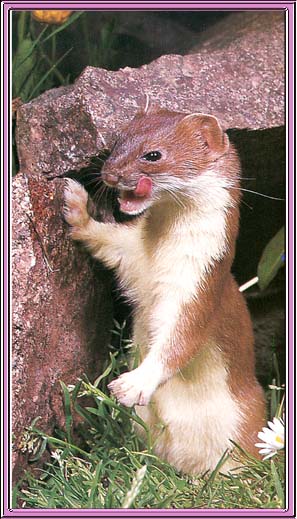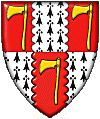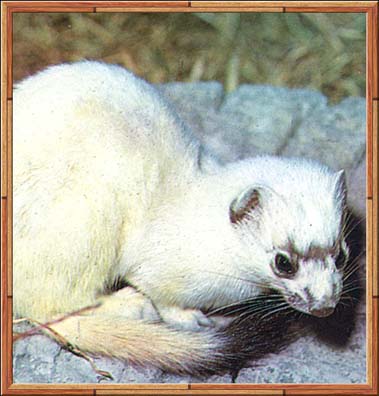
Mustela erminea
The Stoat
The Stoat is one of the fiercest predators and is active by day and by night, it relentlessly tracks it's prey by scent, and apparently it licks the blood off it's prey's fur leading to the old wives tale that it sucks blood. The victim is killed by pouncing on it and biting deeply into the back of the neck near the base of the skull. It was virtually driven to extinction in the 1950's when myxomatosis was introduced, as rabbits are it's main sources of prey. It was only the fact that stoats eat many other types of prey even insects that it was able to survive. A stoats hunting ground is usually about 50 acres although it can be more if prey is scarce. Like it's relations it's den is a rock crevice or a disused rabbit burrow and it normally lives alone. In winter the coat of the stoat turns white (see below) all except for the tip of it's tail which is black (it is said to be in ermine). This is the fur fur that This colour change depends on the length of the days. In Northern Scotland the change is complete with the stoat having a creamy coloured coat, whilst down in Southern England the animal remains brown with creamy white under parts. Like the weasel the margin between the brown and the white is different in every animal. Stoats are legally protected in Eire but not in the United Kingdom. Stoats don't like to be out in the open and so tend to hunt along ditches, hedgerows and walls or through meadows and marshes. They search each likely area systematically, often running in a zig-zag pattern.
Biology:
Size: head and body, about 25cm, tail 76mm or more. Females may be 50% smaller than male. In North America they are quite a lot larger. Weight: 140 - 445g.
Life-span: average one to one and a half years. Can live up to 7 years.
Breeding: Stoats are solitary animals and only socialise with each other in the breeding season. Mating occurs July to mid-August, but the fertilised eggs within the female do not begin developing until up to 10 months later, so that the female does not give birth until the following spring around April or May. This is called delayed implantation and is the same as the delay with the Pine Marten.
Litter Size: Some sources say 3-4 some sources say 6-12. For sake of argument let us say that the litter size is 3-12 then that covers all the bases.
The eyes of the young or kittens do not open until they are about a month old and they are covered in fine white fur with it being thicker at the scruff of the neck so that the mother can carry them with out her teeth penetrating the skin. weaning takes place at 6-8 weeks and at about 6 weeks old the black tip appears at the end of their tails. Like the other members of this genus they stay together as a family for about a month before going their own way.
The ceromonial ermine cloak worn by medieval kings and queens was made from ermine. Because of its white coloring, the ermine is a symbol of moral purity and innocence. Its fur is attached to the robes and mozettas of various dignitaries, including those of the Roman Catholic Church, as a reminder of the purity and innocence their office requires in motive, discipline, behavior, and teaching. Like other white creatures, this carnivore is a symbol of Christ's innocence. Because its coat turns brown in the summer, the white ermine seems to die in the spring and be reborn in the winter. Therefore it is a symbol of Christ's Resurrection.
In the past, the ermine was believed to be an amphibious creature which preferred death to the soiling of its fur. According to Aelian, ermine, falling into a mud puddle, would immediately die of horror. Another myth was that hunters easily caught ermine by smearing mud on the entrances of the creatures' homes. Rather than sully their coats, by running through the dirty entranceway, the ermine, exhausted by the chase and unable to escape the hounds, would wait outside their homes for the hunters to kill them. Thus the ermine became associated with phrases such as "Death before Dishonor." This animal appears on coats of arms as the emblem of knights who would perform any unpleasant deed and suffer any hardship, including death, rather than stain their reputation or conscience.
This pattern was imitated in heraldry, as early as the second half of the 12th c., and came to be one of the two main furs. Its appearance is a white field with a regular pattern or semy of ermine spots. The shape of the spot varied over time and place, although its standard form nowadays is that of 3 dots arranged in triangle, with a kind of tail extending downward and flaring out. The spot itself is a charge, and can be used on its own, in specified numbers, or to form a design. Below are a couple of examples of the ermine displayed on a shield.


